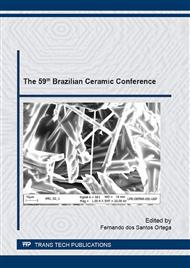p.422
p.427
p.433
p.441
p.447
p.453
p.459
p.464
p.471
The Use of Long Chain Diol for Obtaining Nickel Embedded in Silica-Carbon Matrix through the Polymeric Precursor Method
Abstract:
Silica-carbon composites have large surface area and porosity and combines low density with refractoriness and high corrosion resistance, which make it a good choice for application as mesoporous matrix for composite catalysts. The insertion of nanoparticulate active phase can originate new properties for that composite type, such as catalysts for industrial methane hydro-reforming or other applications. However, there is a strong dependence among the composite morphology, active phase dispersion and porosity, originating a wide variation in the final properties. In this work, the Precursor Polymeric Method was modified to insert a long chain diol as polymerizing agent in order to insert large amount of carbon phase in the composite. The samples were obtained through the pyrolysis of the polymeric precursor prepared with tetraethylene glycol. Composite samples with high dispersion of nickel nanoparticles were obtained even after 1 hour of pyrolysis, but the porosity showed to be dependent of time of pyrolysis, mainly for mesopores with 3.8 nm in diameter.
Info:
Periodical:
Pages:
447-452
Citation:
Online since:
November 2016
Keywords:
Price:
Сopyright:
© 2017 Trans Tech Publications Ltd. All Rights Reserved
Share:
Citation:


